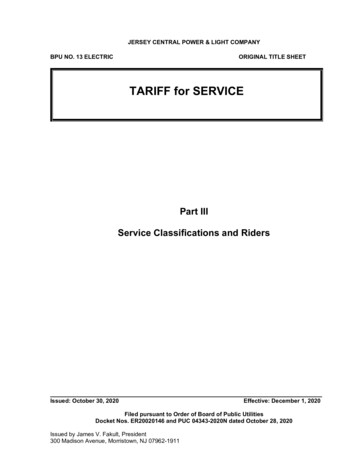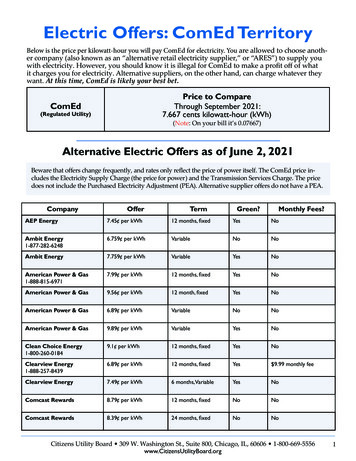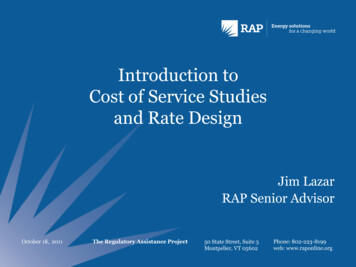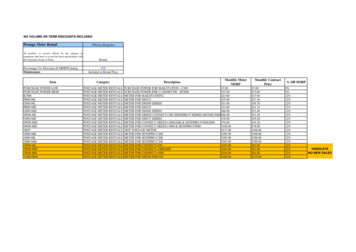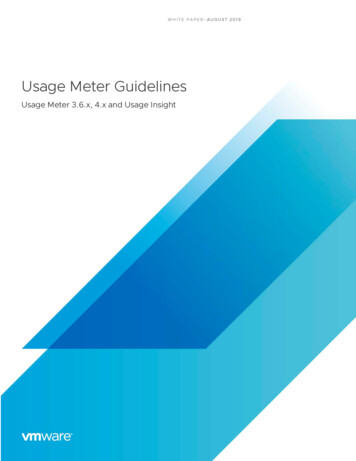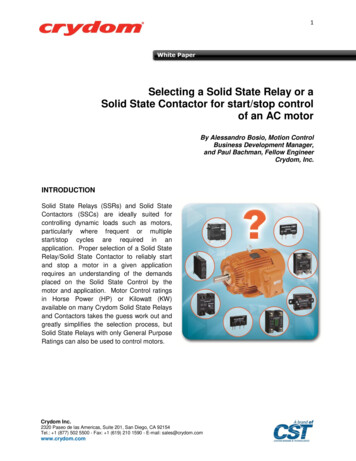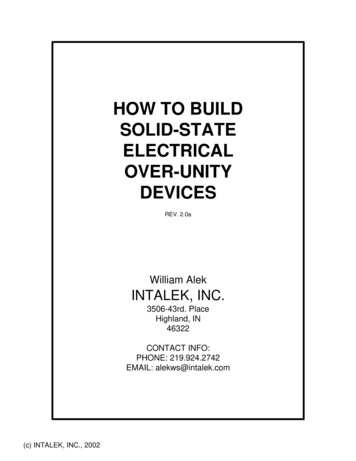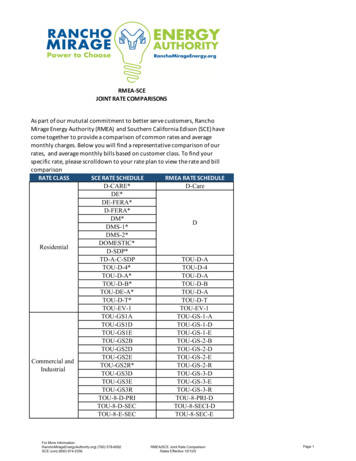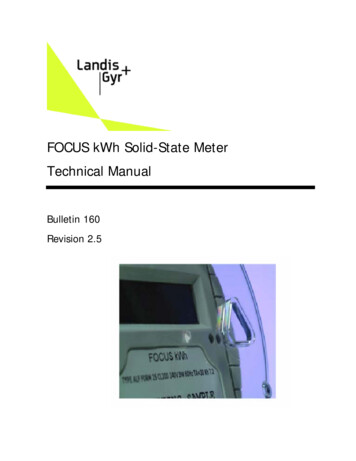
Transcription
FOCUS kWh Solid-State MeterTechnical ManualBulletin 160Revision 2.5
Information in this document is subject to change without notice. No part of this document may bereproduced or transmitted in any form or by any means, electronic or mechanical, for any purposewithout the express written permission of Landis Gyr, Inc. 2003 Landis Gyr, Inc.All rights reserved.For further information, contact:Landis Gyr, Inc.Meter Division2800 Duncan RoadLafayette, IN 47904-5012 USATel. 765-742-1001Document HistoryTitle: FOCUS Solid State Meter Technical ManualDocument Number: Bulletin 160RevisionDateLevelIssuedDescriptionOriginal (1.0) 1/04Initial Issue2.010/19/04Rev. Cellnet FCC#2.111/8/04add note #3 to FCC info.2.211/1/05add Neptune FCC#2.312/13/05add Industry Canada Verbiage2.410/10/06add Current Technologies FCC #2.512/22/06add accessoriesi
TABLE OF CONTENTSPURPOSE . IVTARGET GROUP . IVCONDITIONS. IVSAFETY WARNINGS . IV1.INTRODUCTION TO THE FOCUS . 12.THE FOCUS METER FAMILY. 43.METER ASSEMBLY . 54.APPLICATION INFORMATION . 75.OVERVIEW OF ELECTRONIC HARDWARE . 126.CONFIGURING THE METER . 157.METER CALIBRATION . 168.DATA RETENTION . 179.PULSE OUTPUTS . 1810. FOCUS ACCESSORIES . 2011. PRODUCT SPECIFICATION . 22TABLE OF FIGURESFIGURE 1- BASIC OPERATION DIAGRAM . 1FIGURE 2 – METER ASSEMBLY . 1FIGURE 3 - METER ASSEMBLY EXPLODED VIEW . 2FIGURE 4 - BASEPLATE ASSEMBLY EXPLODED VIEW . 2FIGURE 5 - ELECTRONICS HOUSING ASSEMBLY EXPLODED VIEW . 3FIGURE 6 – KWH FOCUS. 4FIGURE 7 – REMOVAL OF ELECTRONICS HOUSING . 5FIGURE 11 – FORM 1S . 7FIGURE 12 – FORM 2S, 2SE. 8ii
FIGURE 13 – FORM 2K . 9FIGURE 14 – FORM 3S . 9FIGURE 15 – FORM 4S . 10FIGURE 16 – LIQUID CRYSTAL DISPLAY. 12FIGURE 17 – CALIBRATION LED LOCATION . 16FIGURE 18 – SUGGESTED KYZ OUTPUT CONNECTION . 18FIGURE 19 - KYZ BOARD/CABLE, MOUNTING SCREW AND SPACER. 19FIGURE 20 - FOCUS MOTHER BOARD 10-PIN HEADER . 19FIGURE 21 - FOCUS KYZ INSTALLED ONTO MOTHERBOARD . 19FIGURE 22– FOCUS COVERLESS PROGRAMMING ADAPTER #71723-1 . 20FIGURE 23 - #71723-1 INSTALLED IN METER . 20FIGURE 24 – FOCUS PROGRAMMING COVER #71222-1. 20FIGURE 25 –FORM 2K METER TEST ADAPTER #9707-8009, TO TEST METER IN SOCKET TYPE TEST BOARD. 21TABLE OF TABLESTABLE 1 - FORM 1S SPECIFICATION . 7TABLE 2 - FORM 2S/2SE SPECIFICATIONS . 8TABLE 3 - FORM 12S/25S SPECIFICATIONS . 8TABLE 4 - FORM 2K SPECIFICATIONS . 9TABLE 5 - FORM 3S SPECIFICATIONS . 9TABLE 6 - FORM 4S SPECIFICATIONS . 10TABLE 7 - METER ERRORS . 14TABLE 8 - FOCUS OPTIONS . 18TABLE 9 – FOCUS KYZ CABLE COLORS . 18TABLE 10 – KWH FOCUS PULSE INITIATOR OUTPUTS . 19iii
PurposeThis technical manual contains the following information: Installation instructions, construction, characteristics and maintenance information Performance and technical dataTarget GroupThe contents of this technical manual are intended for technically qualified personnel of energy supplycompanies responsible for the system planning, installation, commissioning, operation, maintenance,decommissioning and disposal of the meters.ConditionsThis technical manual is for personnel who are qualified and have received instructions in basicelectrical principles, including safety procedures for installation of energy meters.Safety WarningsThe following safety precautions must be observed during all phases of operation, service, and repair ofthis device. Failure to comply with these precautions or with specific warnings elsewhere in this manualviolates safety standards of design, manufacture, and the intended use of the metering instrument.Landis Gyr, Inc. assumes no liability for the customer's failure to comply with these requirements.!Warning All applicable electrical codes and standards must be followed.Failure to use sufficient insulation on option or I/O cables connecting to the meterthrough the mounting device could cause serious personal injury, property damage,and/or death.Any work on, or near, energized meters, meter sockets, or other metering equipment can present adanger of electrical shock. All work on this product should be performed only by qualifiedelectricians and metering specialists in accordance with local utility safety practices, utilityrequirements, and procedures outlined in Chapter 14 of The Handbook for Electricity Metering (9thEdition). The information contained within this manual is intended to be an aid to qualified meteringpersonnel. It is not intended to replace the extensive training necessary to handle meteringequipment in a safe manner.Use care when servicing with the power on.!Warningiv
The use of I/O cables in ungrounded services could cause serious personal injury, property damage,and/or deathThe FOCUS does not have an auto-ranging power supply. Care should be taken to ensure thatmeters are installed correctly, matching meter form and voltage with the installation.1.1.1.Published SpecificationsThe FOCUS kWh is designed in accordance with the specifications listed below.1.1.2. Institute for Electrical and Electronic Engineers (IEEE)IEEE Recommended Practice on Surge Voltages in Low-Voltage AC Power Circuits-C62.41-19911.1.3.American National Standards Institute (ANSI) American National Standard Code for Electricity Metering, ANSI C12.1-2001 American National Standard for Watt-Hour Meters, ANSI C12.10-1997 American National Standard Method of Salt Spray (Fog) Testing, ANSI/ASTM B117-73, (Z118.1-1974) American National Standard for Electricity Meters 0.2 and 0.5 Accuracy Classes, ANSI C12.20-20021.1.4. Underwriters Laboratories (UL)Underwriters Laboratories UL 746C, “Polymeric Materials – Electrical Equipment Evaluations,”December 27, 1995.1.1.5.Canadian Specifications National Standard of Canada, "Specifications for Approval of Type of Electricity Meters, InstrumentTransformers and Auxiliary Devices", CAN3C17M84 Ontario Hydro, "Oscillatory Transient Interference Immunity Test", A-28M-82 Canadian Standard for Terminal Equipment, Terminal Systems, Network Protection Devices,Connection Arrangements and Hearing Aids Compatibility, CS-03Industry CanadaThis Class B digital apparatus meets all requirements of the Canadian Interference CausingEquipment Regulations.Operation is subject to the following two conditions: (1) this device may not cause harmfulinterference, and (2) this device must accept any interference received, including interference thatmay cause undesired operation.Cet appareillage numérique de la classe B répond à toutes les exigences de l'interférencecanadienne causant des règlements d'équipement. L'opération est sujette aux deux conditionssuivantes: (1) ce dispositif peut ne pas causer l'interférence nocive, et (2) ce dispositif doit acceptern'importe quelle interférence reçue, y compris l'interférence qui peut causer l'opération peu désirée.v
1.1.6.FCC Information:This device complies with part 15 of the FCC rules. Operation is subject to the following threeconditions:(1) This device may not cause harmful interference, and(2) This device must accept any interference received, including interference that may cause undesiredoperation.(3) For RF exposure, service personnel are to maintain a minimum of 20cm from the RFcommunications transmitter once installed.Changes or modifications not expressly approved by Landis Gyr could void theuser’s authority to operate the equipment.Do not change the original antenna without pre-approval from the originalmeter manufacturer. This will violate the FCC regulations of using the radio.Note:Some FOCUS meters may contain AMR modules with RF communications. This equipment has beentested and found to comply with the limits for a class B digital device, pursuant to part 15 of the FCCRules. These limits are designed to provide reasonable protection against harmful interference in aresidential installation. This equipment uses and can radiate radio frequency energy and, if not installedand used in accordance with the instructions, may cause harmful interference to radio communications.However, there is no guarantee that interference will not occur in a particular installation. If thisequipment does cause harmful interference to radio or television reception, which can be determinedby turning the equipment off and on, the user is encouraged to try to correct the interference by one ormore of the following measures:-Reorient or relocate the receiving antenna.-Increase the separation between the equipment and receiver.-Connect the equipment into an outlet on a circuit different from that to which thereceiver is connected.-Consult Landis Gyr or an authorized technician for help.Following are FCC identification numbers for radio systems currently used on FOCUS:Cellnet FCC ID: ROV-CLTR900MNeptune FCC ID: P2SNTGSRFE01StatSignal FCC ID: ROV-1MWR9165Current Technologies FCC ID: TY7210-0137-0001vi
1.Introduction To The FOCUSThe FOCUS meter was designed to be a low-cost, solid-state, kWh-only meter as an alternativemetering and AMR platform to the induction meter. The meter is based on reliable, field proven digitalmultiplication measurement technique. The meter platform will measure energy accurately overvarying environmental conditions. It is designed to be stable over its long expected life. A diagram ofbasic operation is noted below.Figure 1- Basic Operation DiagramFigure 2 – Meter Assembly1
Figure 3 - Meter Assembly Exploded ViewThe FOCUS meter is composed of three basic sub-assemblies: The baseplate assembly, the electronicshousing assembly and the meter cover. The electronics housing assembly snaps onto the baseplateand creates a weatherproof seal when the cover is installed. The standard cover includes an emboss toalign an optical probe for register configuration purposes.Baseplate AssemblyFigure 4 - Baseplate Assembly Exploded ViewThe baseplate module is constructed of highly durable thermoplastics. Inside the baseplate are thecurrent transformer and current carrying parts.2
Electronic Housing AssemblyFigure 5 - Electronics Housing Assembly Exploded ViewThe Electronics Housing contains the measurement board and any optional electronics assemblies suchas option boards or communication devices. It also contains the liquid crystal display (LCD) on whichmeter readings and other pertinent data can be displayed. The Electronics Housing assembly snapsonto the baseplate and can be removed and reinstalled many times without damage to the meter.3
2.The FOCUS Meter FamilyThe FOCUS provides more than just reliability and accurate billing data. The FOCUS is designed to bea building block for a complete metering system. Each FOCUS has built-in compatibility for a variety ofAMR packages. Any of these can be factory installed. Some can be added to the meter dependentupon the meter vintage and respective AMR technology.Register TypesThe FOCUS kWh is an active energy “kWh-only” meter. It is capable of measuring and displayingkilowatt-hours delivered to and received from a load.The energy accumulation register has capacity to display 999999 kWh for all meter forms withoutoverflowing.The meter supports four energy metric displays: kWh (energy delivered to the load) -kWh (energy received from the load) NET kWh (the net energy consumed by the load, or negative kWh subtracted from positivekWh) ADDED kWh (negative kWh added to positive kWh-also referred to as security mode)Figure 6 – kWh FOCUS4
3.Meter AssemblyRemoval of the Electronics Housing from the BaseplateIn rare instances, it may be necessary to access the inner electronics of the FOCUS meter. To removethe Electronics Housing from the baseplate, set meter on a solid surface and place hands around thebottom of the gray housing where it meets with the baseplate. With thumbs in the 6 o’clock position,while touching both the housing and baseplate, squeeze firmly with thumbs using considerable force, toflex the housing and release the bottom two fasteners located at the 4 o’clock and 8 o’clock positions.It may be necessary to alternate pressure by thumbs until both fasteners are released. Once these twofasteners are released, push gently toward the 12 o’clock position to release the top two fasteners. Thehousing can be lifted off and then the current input connector can be unplugged from the printed circuitboard in the housing assembly. Extra care should be given to lift the housing straight off of thebaseplate to avoid damaging the spring contacts located on the base assembly. Spring contacts shouldbe visually inspected to ensure symmetry with one another.Figure 7 – Removal of Electronics HousingInstallation of the Electronics Housing onto the BaseplateBefore installing the Electronics Module onto the Baseplate, make sure that the Electronics Module andBaseplate are free of foreign debris and that any cables are properly routed to prevent interference withthe meter’s electrical connectors. Attach current input lead connector onto mating connector on printedcircuit board. Line up the 4 slots in the gray electronics housing with the 4 mating snap-on protrusionslocated on the black baseplate. Once aligned, apply gentle force to snap the two assemblies together.Sealing the MeterThe FOCUS meter comes standard with T-seal provision. To gain access to the inside of the meter,the T-seal must be removed (broken). Factory T-seals have unique markings. Many utilities likewisehave T-seals with a unique signature. A missing or broken T-seal on a meter in a field installation canbe an indicator that someone has gained access to the internal meter (unauthorized access). It is alsodesirable that the original factory T-seal remains intact. In the case of warranty considerations, afactory T-seal in place does validate the meter has not been altered. If re-sealing is desired, T-sealscan be installed through the FOCUS cover and baseplate assembly.5
Figure 10 – Formed TSeal After InstallationFigure 10 –Unused T-SealsFigure 10 – T-SealInstalledEach T-seal is installed by fully inserting it through the cover and through the baseplate assembly.Bend the T-seal tab to prevent extraction. Next, bend the T-seal over so that it resides within thebaseplate assembly pocket. Finally, bend the top of the T-seal over so that it is flush against the cover.6
4.Application InformationAvailable Meter FormsThe FOCUS is available in the following meter forms:4.1.1.S-Base Transformer rated: Class 10 & 20: 3S, 4S Self-contained: class 100: 1S Self-contained: class 200: 2S, 12S and 25S (Network) Self-contained: class 320: 2SE4.1.2. K-BaseSelf-contained: class 480: 2KMeter Form Schematic DiagramsSelf-contained meter formsFigure 11 – Form 1STable 1 - Form 1S SpecificationForm1SClass100Test Amps15Volts1207Wire2Kh1.8
Figure 12 – Form 2S, 2SETable 2 - Form 2S/2SE SpecificationsForm2S2S2SE2SEClass200200320320Test igure 13 – Form 12S (Network)– Form 25S (Network)Form12S25SClass200200Test Amps3030Volts120/208120/2088Wire33Kh14.414.4
Figure 13 – Form 2KTable 3 - Form 2K SpecificationsForm2K2KClass480480Test 6.6Transformer Rated Meter FormsFigure 14 – Form 3STable 4 - Form 3S SpecificationsForm3S3S3S3SClass10201020Test Amps2.52.52.52.5Volts1201202402409
Figure 15 – Form 4STable 5 - Form 4S SpecificationsForm4S4SClass1020Test Amps2.52.5Volts240240Wire33Kh.6.6The form 3S features a movable fifth terminal that can be located in the 3 o’clock or 6 o’clock centeredlocations. Forms 12S and 25S (Network) feature a movable fifth terminal that can be located in the 3o’clock, 6 o’clock centered, or 6 o’clock offset locations.Installation Procedures1). Remove meter from the box, checking for any cables or connectors that may have been damaged.2). Make sure that the meter type, form, and class match the installation.3). Install meter in the appropriate socket.Warning!All applicable electrical codes and standards must be followed. Any work performedaround the meter including installation must be conducted by qualified meteringpersonnel. Failure to use proper safety practices could cause serious personal injury,property damage, and/or death. Use care when servicing with power on. The FOCUS meter has a Single Voltage Supply.10
4.1.3.Socket base1). Compare wiring with diagrams of Section 3.2 to make sure the meter is wired properly.2). Plug meter terminal blades into socket to make a connection with the terminal jaws.3). Apply load.4). Check to make sure that the LCD operates and sequences through the display items which wereprogrammed into the meter.4.1.4.K-Base1). Compare the wiring with diagrams of Section 3.2 to make sure the meter is wired properly. Installbypasses (if change-out).2). Install the meter on the studs in the K-mounting device.3). Tighten down nuts securely to torque requirements listed inside the socket. Remove bypasses (ifchange-out).4). Apply load5). Check to make sure that the LCD operates and sequences through the display items which wereprogrammed into the meter.11
5.Overview of Electronic Hardware5.1.1.LCD DisplayFigure 16 – Liquid Crystal DisplayThe kWh FOCUS LCD shows the digital power indicator, nominal service voltage and variousselectable metrics.5.1.2.Display Scroll Sequence:The display scroll sequence is programmable at the factory or by the user with FOCUS ConfigurationTool. The scroll sequence can consist of up to 16 individual displays. The display choices are: kWh -kWh NET kWh ADDED kWh (Security) Segment Check with Active DPI Line Voltage(s)Duplicate display choices are permitted as long as the total number of display choices in the scrollsequence does not exceed 16.The time of display can be programmed from 1 to 15 seconds in one-second increments.12
When internal meter errors occur, error codes will be added to the end of the scroll sequence.The segment check display does not affect the DPI. This permits a user to use the DPI for timing whena segment check is being displayed during a scroll sequence.A two character programmable alphanumeric label can be associated with each display. This twocharacter field is used to identify the value displayed. It can be left blank if desired.5.1.3.Display FormatThe display accommodates the following digit formats: 6x1 5x1 4x1 4x10 (Four digit display with the least significant digit representing 10kWh per increment)The energy display format is programmable at the factory or by the user with FOCUS ConfigurationTool. Display format does not affect the segment check, meter error codes or line voltage readings.5.1.4.Digital Power IndicatorThe FOCUS kWh has a digital power indicator similar to the Landis Gyr traditional “caterpillar” andconsists of six segments.The DPI moves from left to right at a rate proportional to energy delivered to the load and moves fromright to left at a rate proportional to the energy received from the load.The DPI makes one revolution for each Kh of metered energy.Each DPI segment on/off transition is observable when occurring at a maximum rate of one on/offtransition each .45 second at –20ºC and above.5.1.5.Power Up Display SequenceAll FOCUS kWh display segments, including the DPI segments, illuminate after the meter is powered upregardless of the display sequence program. This segment check display persists for less than fiveseconds upon meter power-up, after which time the display begins its programmed scroll sequence.13
Diagnostics/Error Codes5.1.6.Meter ErrorsThe following table contains the meter errors available for display in the diagnostic status word.Meter ErrorsError CodesUnprogrammed*1 000001Configuration Error*1 000010Self Check (microprocessor status)*1 000100RAM Error*1 001000Nonvolatile Memory Error (EEPROM)*1 010000Measurement Error*1 100000Table 6 - Meter ErrorsAll diagnostic errors are displayed at the end of the scroll sequence by means of a single six-digitdiagnostic status word prefixed with a *1. The user has the ability to mask each individual error codefrom being displayed via the configuration tool. If an error code is displayed, the meter must be masterreset with the FOCUS Configuration Tool software to clear the error.5.1.7.Power Outage CounterThe user has the ability to read a power outage counter via the configuration tool. The power outagecounter resets following a master reset procedure.14
6.Configuring the Meter6.1.1.Configuration PortThe ability to configure the meter is provided through a secure meter configuration port. A covermounted optical configuration port accommodates meter configuration by the user. The configurationport is designed to be used in a meter shop environment, (room temperature/ambient lightingconditions). The configuration port interface supports a read/write security function.The configuration port can be completely disabled by means of a mechanical plug placed into the rightside optic port so that meter communications cannot be enabled without breaking the meter securityseal to remove the plug. This option is available for utilities that require the meter seal to be brokenand cover removed to allow reconfiguration of the meter.6.1.2.Initial Power-Up and OperationKWH FOCUS meters are always shipped programmed in a configuration defined at the time an orderis placed. They are ready for field installation.6.1.3.Billing Data Reset/PresetThe contents of the kWh and–kWh accumulation registers are user programmable through an opticalconfiguration port. In its simplest form, this feature allows the user to reset the contents of the kWhand –kWh accumulation registers. This feature also enables the user to clear any accumulated energyfollowing meter verification testing.The user also has the ability to enter initial energy values into the kWh and –kWh accumulationregisters. This feature allows a user to pre-load energy values into a replacement meter before it goesinto service.The user can perform this function in a meter shop6.1.4.Display MultiplierThe user has the ability to program a display multiplier. kWh values contained in the energy registersare multiplied by the display multiplier prior to being displayed in the LCD. The display multiplier doesnot affect the contents of the internal energy registers. If direct reading is desired on transformer ratedinstallations, it can be accommodated via this programmable multiplier.The display multiplier can be any value from 1 to 240.15
7.Meter Calibration7.1.1.Calibration LEDThe FOCUS kWh has an infrared light emitting diode (LED) that emits energy pulses. The calibrationLED is deactivated 24 hours after the meter powers up. Once reactivated (recycle power), thecalibration LED remains active for 24 hours.The calibration LED is accessible from the front of the meter cover. The user can fix an LED pickupdevice to the front of the meter.The calibration LED is enabled to produce stable pulses in no more than two seconds following meterpower up.The calibration LED produces pulses in response to energy whether it is delivered (positive) or received(negative).Registration verification testing requires no more than 30 seconds at full load.Figure 17 – Calibration LED Location16
7.1.2.Factory CalibrationThe meter is calibrated at the factory as part of the manufacturing process. Calibration constants arestored in nonvolatile memory. These constants are not alterable once programmed except throughanother calibration cycle at the factory. Sufficient security features are provided to prevent the userfrom altering the calibration constants stored within the meter.7.1.3.Customer Calibration AdjustmentFOCUS kWh calibration is adjustable. Calibration biases may be adjusted by means of a calibration toolvia the configuration port.It is believed that the FOCUS meter will not need recalibration during its life but allowance foradjustments has been provided should the utility want to modify the registration at some point in time.8.Data RetentionAll billing data is stored in nonvolatile memory. Billing data is retained during loss of power to themeter.17
9.Pulse OutputsThe FOCUS kWh offers three internal solid-state pulse initiator outputs.Refer to Landis Gyr FOCUS kWh Pulse Outputs Application Note (Doc. No. 04061-0) for detaileddescription of Pulse Outputs Functionality.9.1.1.Relay #1 Output (KYZ only)KYZ is available as an option to the FOCUS meter. The option board can be assembled in the meter atthe time of order or can be meter shop retrofitted.kWh FOCUS OptionsOne Relay:Programmable for KYZ. (Form C, 3 wire)Table 7 - FOCUS OptionskWh FOCUSOption Cable Colorswire #123descriptionRelay 1N/ORelay 1N/CRelay 1Commonwire colorYellowBlackRedTable 8 – FOCUS KYZ Cable ColorsRELAYFigure 18 – Suggested KYZ Output Connection18
In the kWh FOCUS, pulse initiator signals are provided by Relay 1. The KYZ output value can be anyone of the three choices listed in Table 10 below:Metric ChoicesSelect any one1). kWh2). –kWh3). Added (Security) kWhTable 9 – kWh FOCUS Pulse Initiator OutputsFigure 19 - KYZ Board/Cable, Mounting Screw and SpacerFigure 20 - FOCUS Mother Board 10-Pin HeaderFigure 21 - FOCUS KYZ Installed Onto Motherboard19
9.1.2.Communications (Pulse Initiator 1 and 2)FOCUS kWh provides two scalable TTL-level pulse outputs for interfacing with pulse accumulating AMRmodules. Each output is user configurable to function in one of two operating modes: 1) QuadraturePulse and 2) Differential kWh Pulse. These are used only for configuration of factory installed or fieldretrofitted AMR modules (under glass).10.FOCUS accessories10.1.1.Probe AdaptersThe following adapters provide a magnetic attachment for using an optical probe during lab testing.Both of these adapters require removal of the standard meter cover.Figure 22– FOCUS coverless Programming adapter #71723-1Figure 233 - #71723-1 installed in meterFigure 244 – FOCUS Programming Cover #71222-120
10.1.2.K-Base Test AdapterFigure 255 –Form 2K Meter Test Adapter #9707-8009, to test meter in socket type test board21
11.Product SpecificationGeneral Specifications Active Energy “
1.1.3. American National Standards Institute (ANSI) American National Standard Code for Electricity Metering, ANSI C12.1-2001 American National Standard for Watt-Hour Meters, ANSI C12.10-1997 American National Standard Method of Salt Spray (Fog) Testing, ANSI/ASTM B117-73, (Z 118.1-1974)
